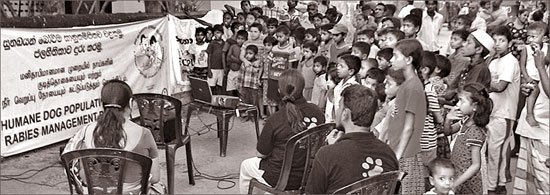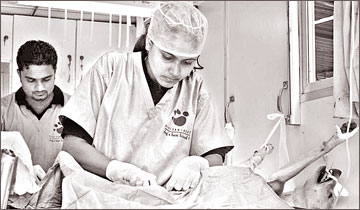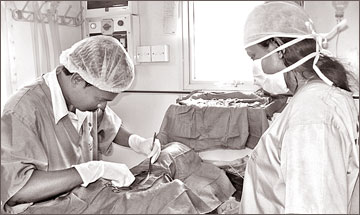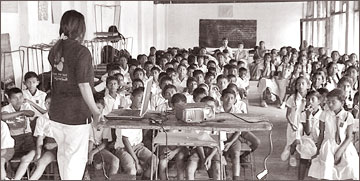|
Humane approach to combat rabies in CMC areas:
Beware of rabies, death lurks
By Ranil Wijayapala
|

Educating the community by the Blue Paw Trust (BPT) on rabies
and stray dogs
|
The Rabies Ordinance of 1896 and the Dog Registration Ordinance of
1908, the two pieces of legislation as amended in 1958, very clearly
defines the term stray dog as any dog which is not being led by the
owner or not under the control of the owner as a stray dog.
The centuries old enactments, the only legislation to control dog
population and rabies in the country clearly stipulates that no stray
dog should be found in places defined as public places.
|
Some tips
for dog owners
Dog owners in the city of
Colombo who suspect their dogs have contracted rabies could
contact the Rabies Observation Unit, at No. 23, Magazine
Road Colombo 8. On your request they will send a vehicle to
pick up the dog to be kept under observations. |
However today many stray dogs could be seen in rural and urban areas
alike while the public fear about the spread of rabies is fast growing
as it has become real hazard to them.
Although the law underlines, that no stray dog should be found in
public places, people are rather confused as to why the law enforcement
authorities, have failed to implement the law regarding the stray dogs.
Earlier there were instances, where some local authorities had seized
the stray dogs.
Authorities implementing the law are of opinion that the two
enactments, are very powerful in controlling the stray dogs and the
rabies menace in the country as the law defines even a dog who is not
under the control of the owner as a stray dog and seize it at any time.
The 1958 amendment to the ordinance empowers the respective local
authorities as elected bodies to make their by-laws on the charges and
penalties on dog registration.
According to the existing law the owner has to pay a registration fee
of Rs.5 for a male dog and Rs.7.50 for a female dog within the Colombo
city, and only 25 cents outside Colombo.
|

Dr. S.D. Eleperuma,
Chief Veterinary Surgeon,
Colombo Municipal Council |

Netting-in stray dogs for vaccination |

Sterilization of female dogs by veterinary surgeons of the BPT |
 |

Educating schoolchildren on rabies
Pix courtesy: Blue Paw Trust |
Dr. S.D. Eleperuma, the Chief Veterinary Surgeon of the Colombo
Municipal Council said the CMC seized 300 to 400 dogs per month within
the city limits during 1960.
“Every year we disposed of 3,000 to 5,000 stray dogs using gas
chambers” he said.
If a stray dog is seized by the local authority it has to be kept
under the control of the Local Authority for 72 hours and if no person
makes a claim to the dog the local authority is enforced to dispose of
it, the law states.
It was a bitter experience for Municipal authorities that the dogs
seized were kept for 72 hours at the dog pound at Magazine road, Borella
and then put into the gas chambers to dispose them, of.
“In the gas chambers it takes seven to eight minutes for the dogs to
die. Healthy dogs won’t die when the carbon monoxide rate is not that
high and they die howling and growling inside the gas chambers. Later
the dead bodies are put into the incinerator. The mechanism adopted by
local authorities to seize astray dogs relates many and many tales of
inhumanity involved. There were instances of dogs dying when they are
noosed.
But there were times when health authorities used to put the stray
dogs directly into gas chambers without keeping them for 72 hours to
enable the owners to turn up.
“Sometimes some authorities used to kill stray dogs using a poisonous
stick and jacking it to the dogs”, he said.
“The CMC resorted only to gas chambers”, Dr. Eleperuma added.
There had been instances reported when the dog vans were assaulted by
the people as they were against those unauthordox practices.
It poses problem for the authorities, whether it was an effective way
of getting rid of the stray dogs and controlling the spread of rabies in
the country.
“While we were destroying 4000 to 5000 dogs per year we had
registered 50 to 60 rabid cases confirmed by the Medical Research
Institute, within the Colombo city limits”, Dr. Eleperuma said.
“That was not at all successful as we were getting three to four
confirmed rabid cases per month. So we have to think afresh regarding
the methods we used to control rabies”, he added.
The cityfolk, Animal Welfare Organisations, and dog lovers exerted
pressure on Colombo Municipal Council and the Government to consider new
methods of dealing with the dogs instead of killing them. The number of
stray dogs killed was reduced during the Mayoralty of Prasanna
Gunawardena.
As a mark of respect for the 2550 Sambuddha Jayanthi, the Minister of
Local Government instructed all the 300 odd Local authorities before the
Vesak to abandon killing stray dogs in haphazard manner with the
objective of controlling rabies.“He did not impose a full ban. he said
not to kill the stray dogs with the objective of controlling rabies”,
Dr. Eleperuma added.
He advocated vaccination of all dogs against rabies plus
sterilisation of female dogs to reduce the dog population in the country
instead of killing stray dogs. However, it became a rather difficult job
for the Local Authorities to comply with the Government policy regarding
the stray dogs.
A organisation called, Blue Paw Trust, consisting of number of
veterinary surgeons and some volunteers, however came to assist the
Colombo Municipal Council.
The Blue Paw Trust is an organisation funded by the World Society for
Protection of Animals. It has its headquarters in London, under the
umbrella of World Health Organisation. They have the necessary technical
expertise, veterinary surgeons, animal behaviour scientists and also
vehicles and other equipment.
The CMC formed a public-private partnership with the BPT in 2006.
the local authorities had no idea about the number of stray dogs. The
CMC estimated that there were around 10,000 home dogs in the city.
The CMC had estimated about 25,000 to 30,000 stray dogs for
sterilisation, taking into account the consideration, one dog for every
eight people in the Asian region.
The Blue Paw Trust came up with a comprehensive package to implement
the humane method of dog sterilisation plus vaccination and a scientific
count was conducted to ascertain the number of stray dogs.
The CMC Veterinary Department and the BPT took up the challenge of
vaccinating and sterilising stray dogs estimated around 5,000.Instead of
the nylon rope a nylon net was introduced to catch stray dogs enabling
the dog catchers to carry the dog anywhere and vaccinate or sterilise
it.
“We conducted the sterilisation operation in the area where dogs were
found and we concentrated on areas such as North, Mattakkuliya where
dogs were found in large numbers, Eleperuma said.
The real operation was started in June 2008, after a pilot project
was conducted for over six months.
“Upto now Blue Paw Trust together with the CMC have sterilised more
than 4,500 female dogs. We have sterilised them and left them back in
the same area”, he said.It was after educating the community about the
project the semi owners of the stray dogs were identified and female
stray dogs were sterilised and handed back to them.
“By doing 4500 sterilisations we have prevented 135,000 pups being
born over these two to two and half years”, Eleperuma said.
The Municipality continues the practice of going from house to house
and vaccinate the household dogs.
In 2008 the CMC had vaccinated 6446 dogs and in 2009 the number
increased to 8006. In the first half of this year it has vaccinated 5585
household dogs.
“The BPT has vaccinated more than 2700 stray dogs for the first half
of this year”, he said.
“We have observed a tremendous progress in the rabies control
programme within the city as the number of rabid cases came down
drastically dariy the past few years”, he said.
In 2007 the number of rabies positive cases reported in the Colombo
city was 33 and 17 in 2008. “But in 2009 we had 25 cases of rabies
within the city which was included mongoose and monkeys and other
animals” as well.
“This programme has brought positive results, You can’t do miracles.
You have to vaccinate the dogs whether it is your dog or stray dogs and
also you have to control the dog population by sterilising the female
dogs”, he said.
This exercise has also prevented the unwanted killing of dogs.
A follow-up observation count undertaken by the BPT has shown that
the number of lactating bitches and the pups in the streets has also
come down drastically giving a strong indication that female
sterilisation has produced positive results”, he said.
“Now we have a more mature dog population which is virtually static.
These dogs are getting older and after three to four years they will
have a natural death. The number of pups is becoming lesser and lesser.”
Therefore, we had to raise awareness among the community not to dump
their pups into the streets. If we have their female dogs also
sterilised, it will cut down the number of unwanted pups.“Now the news
is spreading that in Colombo there is a pilot project called Rabies
Eradication and Dog Population Control Project which is the largest
project undertaken by WSPA”, Eleperuma added.
“But, we have not altogether eradicated rabies from Colombo city. Our
figures are very encouraging. The Government aim is to eradicate rabies
in 2016.
Our target is to eradicate rabies from Colombo by 2014. I think we
are not far away from that target” Eleperuma said.
Despite the success of this project, Dr. Eleperuma is still to
cautious about the situation and appeals to the public to admit
themselves to Colombo National Hospital if they are bitten, scratched or
licked by an unknown dog.
“Whether you are keeping a dog, cat, deer or whatever animals give
them the rabies vaccination and keep them indoor, tied he said. |

